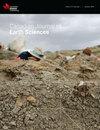阶梯式正碳同位素偏移(SPICE)记录寒武纪,白边)来自纽芬兰西部的牛头群
IF 1.6
4区 地球科学
Q3 GEOSCIENCES, MULTIDISCIPLINARY
引用次数: 0
摘要
生物地层定年分析表明,纽芬兰西部浅湾组唐斯角段碎屑流砾岩中存在阶梯式正碳同位素偏移(SPICE)。根据无尾虫和三叶虫的组合,将15块由生物碎屑碳酸盐组成的巨石划分为5个动物群。glyptagnotus reticulatus和“innitagnotus”异型动物群对应于记录SPICE上升翼的地层,位于内华达州和犹他州的类型区,而对应的acmarhachus kindlei动物群则位于记录δ 13c峰值的区间。Crepicephalus动物群和Triorygma burkhalteri动物群分别对应于spice前和后地层。与SPICE相关的3个动物群的δ 13 C值均显著高于SPICE前和SPICE后的“背景”水平,但A. kindlei动物群的最大值(1.5‰)不到内华达州和犹他州峰值的一半。然而,这些数值与纽芬兰港港半岛的报告一致,达到2.2‰。纽芬兰和内华达-犹他之间的强度差异暗示了SPICE在劳伦森大陆不同地理区域的表达差异,这可能反映了海洋学条件。本文章由计算机程序翻译,如有差异,请以英文原文为准。
A record of the Steptoean Positive Carbon Isotope Excursion (SPICE; Cambrian, Paibian) from the Cow Head Group, western Newfoundland
Analysis of biostratigraphically dated boulders demonstrates that the Steptoean Positive Carbon Isotope Excursion (SPICE) is recorded in debris flow conglomerates of the Downes Point Member of the Shallow Bay Formation in western Newfoundland. Fifteen boulders composed of bioclastic carbonates were assigned to five faunas based on assemblages of agnostids and trilobites. The Glyptagnostus reticulatus and “ Innitagnostus” inexpectans faunas correlate into strata that record the rising limb of the SPICE in its type area of Nevada and Utah, whereas equivalents of the Acmarhachis kindlei Fauna lie in the interval that records peak δ 13 C values. The Crepicephalus and Triorygma burkhalteri faunas correlate into pre- and post-SPICE strata, respectively. δ 13 C values for boulders from the three faunas correlative with the SPICE are significantly higher than “background” levels of the pre- and post-SPICE boulders, but the maximum value in the A. kindlei Fauna (1.5‰) is less than half of the peak values recorded in Nevada and Utah. The values are, however, in line with those reported from the Port au Port Peninsula of Newfoundland, which reach 2.2‰. The differences in magnitude between Newfoundland and Nevada–Utah hint at differences in the expression of the SPICE in different geographic regions of the Laurentian continent that might reflect oceanographic conditions.
求助全文
通过发布文献求助,成功后即可免费获取论文全文。
去求助
来源期刊

Canadian Journal of Earth Sciences
地学-地球科学综合
CiteScore
2.80
自引率
7.10%
发文量
66
审稿时长
6-12 weeks
期刊介绍:
The Canadian Journal of Earth Sciences reports current research in climate and environmental geoscience; geoarchaeology and forensic geoscience; geochronology and geochemistry; geophysics; GIS and geomatics; hydrology; mineralogy and petrology; mining and engineering geology; ore deposits and economic geology; paleontology, petroleum geology and basin analysis; physical geography and Quaternary geoscience; planetary geoscience; sedimentology and stratigraphy; soil sciences; and structural geology and tectonics. It also publishes special issues that focus on information and studies about a particular segment of earth sciences.
 求助内容:
求助内容: 应助结果提醒方式:
应助结果提醒方式:


